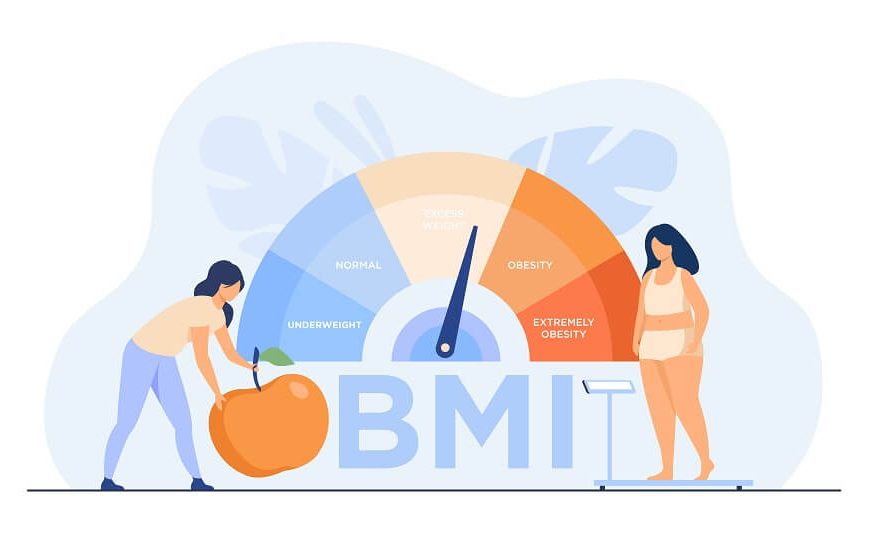‘What is your Body Mass Index?’
That’s a question several people have heard at one point or the other in their lives. While the answer to ‘What’s your Weight?’ is something people have ready at their fingertips, that answer to what their BMI might be seems forever elusive.
In this article you will find everything BMI-related, from what your ideal Body Mass Index should be, to tips you can use to reduce your BMI.
Most of us have a fixed perception of what our weight should be. We might be eating healthy and even exercising plenty, but are we really fit enough? Knowing what your BMI is, might just be that indicator of sound fitness we were seeking all along.
Let us begin, by directly addressing the question, ‘What is Body Mass Index?’
Body Mass Index: The Basics
Simply put, the Body Mass Index (BMI) is a measure that uses your height and weight to work out if your weight is healthy.
The Ranges of BMI
The ideal body mass index for most adults falls in the 18.5 to 24.9 range.
For children and young people between 2 to 18 years, the BMI calculation takes into account not only height and weight, but age and gender, too.
Here is a look at BMI ranges and what they typically indicate.
- Less than 18.5 – this indicates that you are underweight
- 5 – 24.9 – this means you are healthy
- 25 – 29.9 – you are overweight
- 30 and over – you are obese
To state an example, here are the weight ranges, the corresponding BMI ranges, and the weight status categories for a person who is 5’9”.
Height Weight Range BMI Weight Status
5’9” 124 lbs or less Below 18.5 Underweight
125 lbs to 168 lbs 18.5 to 24.9 Healthy Weight
169 lbs to 202 lbs 25.0 to 29.9 Overweight
203 lbs or more 30 or higher Obesity
BMI as an indicator of Body Fat
The correlation between BMI and body fat is pretty strong. That being said, even if two people have the same BMI, their body fat levels may differ.
The following are a few BMI-related facts that you might want to make a mental note of.
- Women with the same BMI, tend to have more body fat than their male counterparts.
- Older people that have the same BMI as young adults, tend to have more body fat.
- Athletes with the same BMI as non-athletes, tend to have less body fat.
How to find Body Mass Index
Want to know how to find Body Mass Index? When using the Metric System, the formula to calculate BMI is,
“Weight in Kilograms divided by Height in Metres Squared.’
Here’s how to calculate BMI using a hand-held calculator:
- If your calculator comes equipped with a square function, you need to divide weight (kg) by height (cm) squared, multiply by 10,000 and round off to a single decimal place.
- If there is no square function in your calculator, you need to first divide the weight by height twice, as shown in the calculation formula above. Then, multiply by 10,000 and round off to one decimal place.
A Body Mass Index chart can also be used to calculate the BMI of a person. There are different BMI charts for males and females.
BMI Interpretation for Children and Teens vis a vis Adults
The fact of the matter is, BMI is interpreted differently in the case of children and teens. This, despite the fact that it is calculated using the same formula used to compute adult BMI.
The thing is, the BMI in children and teens needs to be age- and sex-specific. This is because the amount of body fat changes with age, and the amount of body fat differs between girls and boys.
In the case of adults, the interpretation of BMI does not depend on sex or age.
The Importance of knowing your BMI
The next time your paediatrician shows you a Body Mass Index Chart, you might want to play close attention to it. After all, knowing your child’s BMI is a good way to gauge if their weight is in healthy proportion to their height.
Obesity can be a dangerous thing. It can lead to several complications like the following.
- High Blood Pressure
- Type 2 Diabetes
- Cardiovascular Disease
- Musculoskeletal problems
At the same time, even being underweight can result in some health issues, like the ones outlined below.
- Malnutrition
- Osteoporosis
- Anaemia
Busting the common myths about BMI
Now that we have obtained plenty of information about BMI, here are a couple of myths that you should never fall prey to, along with the hard facts.
Myth: A high BMI means you are unhealthy
Fact: The truth of the matter is, that BMI formula does not take into account all variables involved with body weight. For instance, athletes with greater muscle mass might have a BMI in the overweight range. As can a pregnant woman, who is carrying another human being!
Myth: A low BMI means that you are unhealthy
Fact: Mid-range BMI numbers are the best. While a low BMI might indeed indicate that you are healthy, it could also mean other things. Like the fact that you might be underweight, and have a weak immune system.
Tips to reduce BMI
Want a healthy BMI? Here’s some cool tips you could use.
- Don’t bother with crash diets. A balanced, low-calorie diet is key.
- Get your heart pumping. The more you exercise, the more your chances of lowering your BMI.
- Move more. Sometimes, you might not have the time to work out. That’s no excuse to not exercise, though. You could cycle to work or even use the stairs instead of the elevator. Just move as much as possible!
We at EuroKids believe that the best way for you to know what your child’s BMI means, is to have their paediatrician measure it and discuss the results with you. You can then seek their help, where it comes to your children developing and supporting healthy habits at home.
















